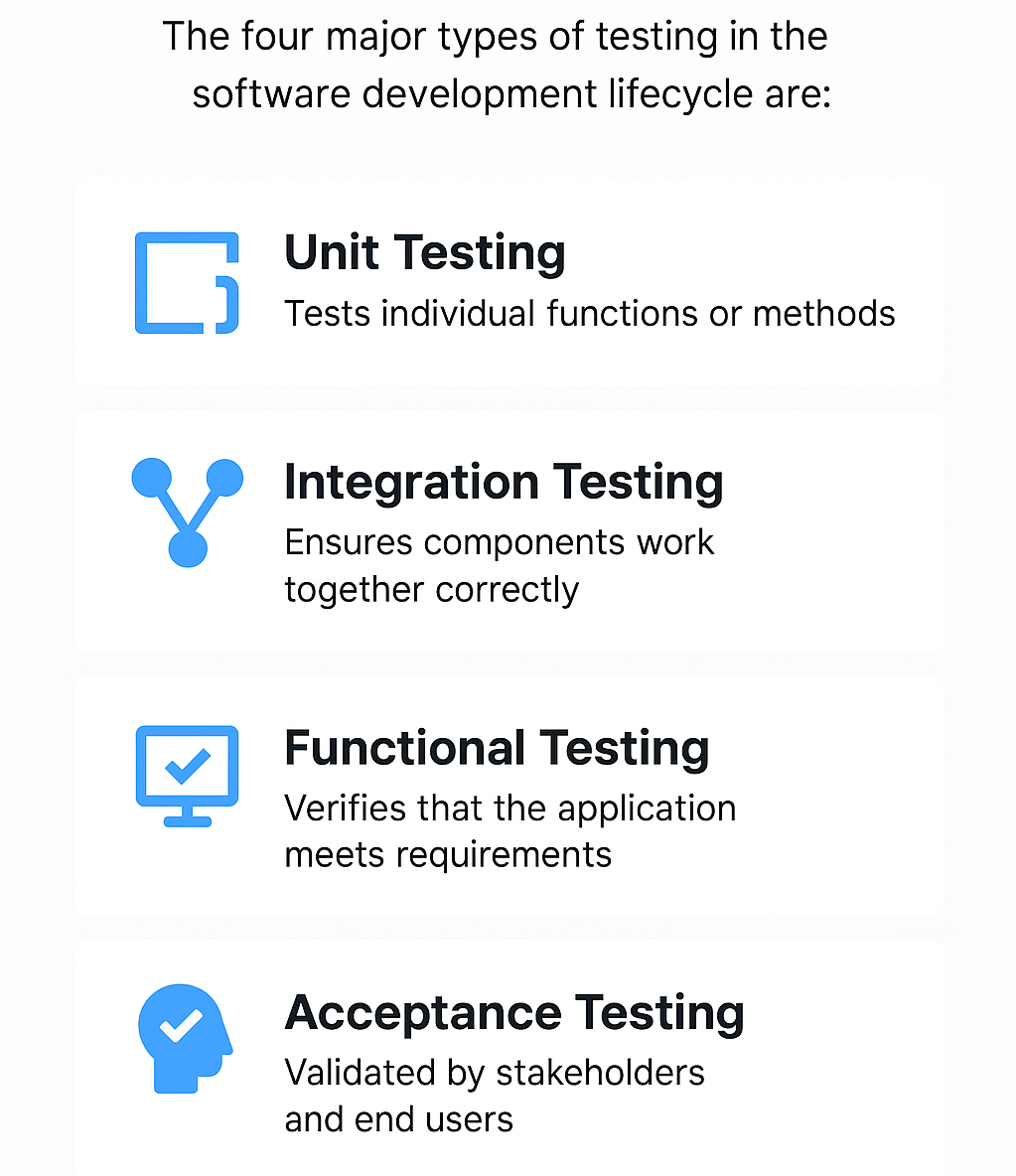When you’re developing software, ensuring that your code works as expected is essential—not just during development, but across future updates and deployments. The most effective way to catch bugs early and maintain reliability is by using a structured testing strategy that includes both automated and manual tests.
Broadly speaking, software testing falls into four main categories:
- Unit Testing
- Integration Testing
- Functional Testing (also known as System Testing)
- Acceptance Testing
Each type of test serves a different purpose and occurs at different stages of the development lifecycle. In this article, we’ll break down what each testing category means, how it contributes to software quality, and what’s involved in automating each type. Whether you’re a developer, tester, or project lead, understanding these testing layers will help you build more stable and maintainable software.
When Should You Write Automated Tests?
Deciding when to write your tests is just as important as deciding what to test. The timing of your test development can dramatically influence how effective, maintainable, and thorough your test suite becomes. Here are four common stages during the software development lifecycle where automated tests are typically written—each with its own trade-offs:
1. While Writing the Software (Most Common Approach)
Writing tests as you develop your code is one of the most widely adopted strategies. This method ensures your tests grow alongside your application. As you build each function or module, you write tests to confirm it behaves as expected. By the time the project is complete, you’ve already accumulated a robust test suite. This approach also makes it easier to catch bugs early, when they’re cheaper and faster to fix.
2. After the Software Is Built (During Validation or QA)
Sometimes, teams wait until the software is functionally complete before writing tests—often during the validation or quality assurance phase. While this can still add value, it’s a less efficient and more error-prone approach. You may need to re-read code you wrote weeks ago to figure out what it was supposed to do, increasing the chance of misinterpretation. This phase is also where testing can easily be de-prioritized, especially under tight deadlines—resulting in poor or incomplete test coverage.
3. When Fixing Bugs
One of the best times to write a test is immediately after fixing a bug. By writing a test that specifically checks for that bug’s behavior, you can ensure it never silently returns. These are sometimes called regression tests. They act as safety nets—if the same bug re-emerges in future versions of your software, the test will fail and alert you before your users ever encounter the issue again. Over time, this creates a self-healing feedback loop that strengthens your codebase.
4. Before You Write the Software (Test-Driven Development – TDD)
In Test-Driven Development (TDD), tests are written before any actual implementation begins. You start by designing the basic functionality and writing tests that define how each piece should behave. Then, you write just enough code to make those tests pass. This process encourages clean, modular design and gives you full test coverage from day one. While it can feel counterintuitive at first, TDD often leads to higher-quality software with fewer defects and less technical debt.
TL;DR:
The earlier you write your tests, the more value they provide. Whether you’re practicing TDD or writing tests as you go, prioritizing testing early in the development lifecycle is the best way to build stable, resilient software. And when bugs do slip through, treat them as opportunities to strengthen your test suite—not just patch the problem.
| When Tests Are Written | Advantages | Disadvantages | Best For |
|---|---|---|---|
| While writing the software | Catches bugs early and builds test coverage alongside development | Might miss edge cases if written quickly | Most modern development teams using CI/CD |
| After the software is built | Useful for validating the full system, often informed by manual QA | Time-consuming, easy to de-prioritize, harder to maintain | Legacy projects, teams without an early testing strategy |
| When fixing bugs | Helps prevent regressions and improves system reliability over time | Reactive—only covers problems after they’ve occurred | Ongoing maintenance, improving weak spots |
| Before writing code (TDD) | Encourages modular, testable code and ensures full coverage from the start | Slower at the beginning and requires discipline | High-reliability systems, Agile teams using TDD |
What Is Unit Testing?
Unit testing is the process of testing individual components of your code—typically functions or methods—to ensure they work as expected in isolation. A unit is the smallest testable part of an application, and by validating each unit separately, you can catch bugs early and make your codebase more maintainable.
Unit tests are the fastest type of automated test. They run quickly because they don’t require database access, external APIs, or complex system setups. This makes them ideal for continuous integration (CI) pipelines, where fast feedback is critical. Since they can often run in parallel, unit tests scale well as your codebase grows, and they provide immediate feedback to developers when something breaks.
Why Unit Testing Matters
Writing unit tests forces you to think through how your code is supposed to behave in different scenarios. By covering the most common and edge cases, you reduce the risk of regressions and unexpected bugs. Unit tests also serve as living documentation, showing how your functions are intended to be used.
Of all the types of software tests, unit tests offer the best return on investment. They’re easy to write, quick to run, and pinpoint issues down to specific lines of code. The earlier you catch a bug, the cheaper and easier it is to fix—and unit tests are your first line of defense.
How Unit Tests Work
Most unit tests follow a simple pattern:
- Set up a test scenario by preparing inputs and the context in which the function should operate.
- Call the function or method you’re testing, using the prepared input.
- Make an assertion about what the output (or resulting state) should be.
For example, suppose you’re testing a function that calculates the total price of items in a shopping cart. Your unit test would provide a mock list of items and assert that the returned total matches what you expect.
Tools and Frameworks
The easiest way to write and manage unit tests is by using a testing framework. In Python, one of the most popular frameworks is Pytest—it’s simple, expressive, and widely supported. Other languages offer their own tools:
- JavaScript: Jest, Mocha
- Java: JUnit
- C#: NUnit, xUnit
- Go: built-in
testingpackage
These frameworks help organize your test files, manage test execution, and provide reporting when tests pass or fail.
Best Practices for Writing Unit Tests
- Test one thing at a time: Each test should focus on a single behavior or condition.
- Be descriptive: Name your test functions clearly so others understand what’s being tested.
- Use both typical and edge cases: Test normal inputs, invalid inputs, and boundary conditions.
- Keep tests fast: Avoid dependencies on external systems like databases or web services.
- Run them often: Integrate unit tests into your CI/CD pipeline to catch issues early.
Learn More about unit testing
If you’re working in Python, check out our in-depth guide: Unit testing in Python.
It walks through examples using Pytest and shows how to structure your tests for long-term success.
What is Integration Testing?
What Is Integration Testing?
Integration testing verifies that different components or services in your system work together as expected. While unit tests focus on individual pieces of code in isolation, integration tests evaluate how those pieces interact—whether that’s between functions, modules, microservices, or external systems like databases, APIs, or third-party tools.
Integration testing can range in complexity. At its simplest, it might involve spinning up a couple of services locally to simulate real interactions. At its most complex, it could mimic a production-like environment with multiple interconnected services. The goal is the same: make sure the parts of your system “play nicely” together under realistic conditions.
Why Integration Testing Matters
Even the most thorough unit tests can miss issues that only appear when components interact. Integration tests catch edge cases and unexpected behavior that arise from the real-world flow of data across services.
Let’s say you’ve built a backend service that converts uploaded Word documents to PDFs. You unit test it thoroughly, feeding it Word files and verifying that the output is correct every time. Everything looks great.
Then, you hook this service up to your web front-end. Users start uploading files, and everything works—until someone tries to upload a JPEG image instead of a Word document. Your code wasn’t designed to handle images, and maybe you hadn’t even considered that possibility. The system crashes or returns an unhelpful error. Your unit tests didn’t fail, but now you have a real-world bug.
Integration testing would help catch this. By simulating realistic interactions—such as files being uploaded from the web interface—you increase the chances of discovering these gaps before they reach end users.
What Integration Testing Helps You Discover
- Mismatches in API contracts (e.g., wrong formats, missing fields)
- Errors caused by unexpected inputs from other components
- Configuration issues (e.g., environment variables, permissions)
- Data flow problems between services or systems
- Missing validations or safeguards that unit tests wouldn’t trigger
The Role of Integration Testing in the Development Pipeline
Integration testing typically comes after unit testing but before full system testing or user acceptance testing (UAT). It serves as a critical checkpoint—confirming that components don’t just work on their own, but work together in a realistic environment.
If issues are found, you can update your code to either:
- Handle the unexpected input or interaction, or
- Fail more gracefully, so the error doesn’t crash the system or confuse the user.
Once fixed, the integration test is re-run to validate the new behavior—and can be added to your automated test suite to prevent regressions in the future.
What is Functional Testing?
Functional testing is a type of software testing that focuses on verifying that the application behaves according to its defined requirements. Unlike unit or integration tests, which are more concerned with how the system works internally, functional tests validate what the system does from the perspective of the user or stakeholder.
In other words, functional testing answers the question: “Does this feature do what it’s supposed to do?” Whether it’s submitting a form, logging in, processing a transaction, or triggering a workflow—this phase ensures that each feature functions as expected under normal usage conditions.
Real-World Examples of Functional Testing
For a web application, functional testing might include:
- Verifying that a login form accepts valid credentials and rejects invalid ones
- Checking that a search bar returns relevant results
- Confirming that a “Submit” button saves data and routes the user to a confirmation screen
- Testing that a shopping cart accurately adds and removes items
Functional tests often mimic user behavior. Tools like Selenium, Cypress, or Playwright can automate browser-based interactions—such as clicking buttons, filling out forms, or navigating between pages—to simulate real user flows. For APIs or backend systems, functional tests might use tools like Postman or REST-assured to validate expected responses to specific requests.
How Functional Testing Fits into the SDLC
Functional testing typically takes place after unit and integration testing. Once the components have been confirmed to work both individually and together, functional testing ensures that the system as a whole meets business and technical requirements. It’s especially useful during:
- Quality assurance (QA)
- Regression testing before a release
- User acceptance testing (UAT)
You can think of this phase as “requirements verification.” It’s where you go down your list of features and say, “Yes, this does what it’s supposed to do,” or, “No, this still needs work.”
Key Benefits of Functional Testing
Builds confidence before product demos, releases, or client handoffs
Helps ensure user-facing functionality is working as expected
Validates technical requirements and acceptance criteria
Identifies bugs that only appear when interacting with the UI or end-to-end flows
Functional Testing in Context
| Test Type | Purpose | Focus | Who/What It Represents | Typical Tools |
|---|---|---|---|---|
| Unit Testing | Verifies individual functions or methods | Isolated pieces of logic | Developer intent | Pytest, JUnit, NUnit |
| Integration Testing | Checks if components work together properly | Interactions between components | System behavior across services | Postman, REST-assured, Docker |
| Functional Testing | Validates that features behave as expected | Business logic and user actions | End user or stakeholder perspective | Selenium, Cypress, Playwright |
What is Acceptance Testing?
Acceptance testing, often referred to as User Acceptance Testing (UAT), is the final phase of testing before software is released into production. At this stage, the focus shifts away from developers and testers to the actual users, stakeholders, or product owners. The goal is simple: confirm that the software works as the customer or end user expects it to—not just according to technical requirements.
While earlier testing stages (like functional and integration testing) focus on correctness, stability, and performance from a system perspective, acceptance testing ensures the product meets the real-world needs of the business or user.
Functional vs. Acceptance Testing
It helps to think of the difference this way:
- Functional Testing: Developers verify that the system behaves as they intended.
- Acceptance Testing: End users validate that the system behaves as they expected.
These aren’t always the same. You might pass every functional test and still fail acceptance testing if the software doesn’t align with the user’s goals, workflows, or mental model. Acceptance testing can reveal oversights like confusing user flows, design mismatches, or features that meet technical specs but don’t satisfy user needs.
What Acceptance Testing Can Reveal
- A feature functions correctly but doesn’t solve the problem it was intended to address
- A design choice creates usability issues that weren’t obvious in earlier stages
- A business rule was misunderstood or missed entirely during development
- Critical edge cases or user expectations weren’t captured in requirements
- Minor bugs that made it past functional testing but would impact real users
Can You Automate Acceptance Testing?
Not easily. Unlike unit, integration, or even functional testing, UAT is usually manual—conducted by business users, stakeholders, or clients. These testers are not typically developers, and they’re not expected to write test scripts or automate flows. Instead, they test by interacting with the software in realistic ways, often using checklists or predefined acceptance criteria.
If you’re automating user-facing flows and validating business logic in a test environment, you’re effectively doing automated functional testing—not UAT. True acceptance testing requires human judgment, particularly when it comes to evaluating usability, clarity, and whether the solution fulfills the original business intent.
Why Acceptance Testing Matters
It builds trust between the development team and stakeholders
It’s your final safety net before releasing to production
It validates whether the software actually solves the user’s problem
It prevents last-minute surprises and unmet expectations
Summary
In this article, we explored the four major types of testing used throughout the software development lifecycle: unit testing, integration testing, functional testing, and acceptance testing. Each plays a unique and essential role in delivering high-quality, reliable software.
- Unit tests catch bugs at the smallest level—individual functions or methods—and provide fast, low-cost feedback.
- Integration tests ensure that components interact correctly, catching issues that only arise when systems communicate.
- Functional tests verify that your application meets its technical requirements and behaves as users expect.
- Acceptance tests provide the final checkpoint, allowing stakeholders and end users to validate that the software truly meets business needs.
The first three types—unit, integration, and functional—can and should be automated to ensure consistency, speed, and repeatability. But acceptance testing typically requires human input. It’s about judgment, experience, and perspective—something automation can’t easily replicate.
When used together, these testing types create a layered safety net that helps you avoid releasing buggy, incomplete, or misaligned software to your users. Invest in all four, and you’ll not only ship faster—you’ll ship with confidence.


